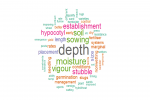Author: Nicole Baxter
182 results found:-

Farm scholar builds a global ‘brains trust’
Author: Nicole Baxter, 2025-04-27T09:00:00+10:00A Victorian mixed farmer travelled Australia and the world to gather ideas to fortify his business against seasonal variation
-

The future of the double-knock
Author: Nicole Baxter, 2025-04-19T09:00:00+10:00An expert in weeds management has outlined a potential approach for dealing with glyphosate and paraquat-resistant weeds
-

Effective stripe rust management starts with variety selection
Author: Nicole Baxter, 2025-04-18T09:00:00+10:00Random surveys across the northern region demonstrate the power of growing wheat varieties with in-built stripe rust protection
-

Winter season starts
Author: Rebecca Thyer and Nicole Baxter, 2025-04-14T09:00:00+10:00Every year, GroundCover™ tracks a group of growers throughout Australia as they navigate the cropping season. Our participants for 2025 detail their enterprises and management strategies in the first part of this year’s series.
-

Agile ‘moisture farmer’ turns flood pain into flood gain
Author: Nicole Baxter, 2025-04-10T09:00:00+10:00A Victoria grain and sheep producer takes the good with the bad when floods arrive, valuing the added moisture they offer to following crops.
-

Autonomy proves a game changer
Author: Nicole Baxter, 2025-04-01T09:00:00+11:00Speaking at a GRDC/Society of Precision Agriculture Australia webinar, Tom Longmire said a SwarmFarm robot has improved weed and pest management on the family’s grain farm near Beaumont, Western Australia.
-

Are you ready for autonomy?
Author: Nicole Baxter, 2025-03-30T09:00:00+11:00With automated on-farm solutions for farm tasks now available, it is worth considering if you are ready for autonomy
-

Farming systems trials go paddock-scale
Author: Nicole Baxter, 2025-03-22T09:00:00+11:00The Southern New South Wales farming systems project has extended small-plot experiments at Condobolin, Greenethorpe, Wagga Wagga, and Urana until 2027. Enhanced research components, co-invested by GRDC, CSIRO, and NSW DPIRD, aim to optimize rain-to-grain conversion. In 2024, new rotations at Wagga Wagga were introduced to study slow-release fertilizers and greenhouse gas emission reduction. The 'Diverse Farms' initiative, added in 2024, extends small-plot results to paddock-scale trials across six farms, focusing on soil nitrogen, weeds, diseases, yields, and profit. Grassroots Agronomy consultants lead this initiative. Keep an eye out for paddock walks over the next three years for insights from researchers and growers.
-

Diversity is a defence against weeds
Author: Nicole Baxter, 2025-03-21T09:00:00+11:00A diverse crop sequence can cost-effectively help reduce the annual ryegrass population. From 2014 to 2017, CSIRO's research at Temora, NSW, funded by GRDC, compared three farming systems' effects on the annual ryegrass seedbank. The initial ryegrass population was 1864 plants per square meter. System 1 used a conservative canola-wheat-wheat sequence, System 2 an aggressive canola-wheat-wheat sequence, and System 3 a diverse vetch-canola-wheat-barley sequence. System 3 significantly reduced ryegrass to 204 plants per square meter and yielded better results, with barley outperforming other crops. This study highlights barley's competitiveness in weed suppression and its resilience in dry conditions.
-

Hardy barley proves its worth in rotation trials
Author: Nicole Baxter, 2025-03-20T09:00:00+11:00Long-term farming systems experiments support barley as a profitable inclusion in canola and wheat rotations


















































